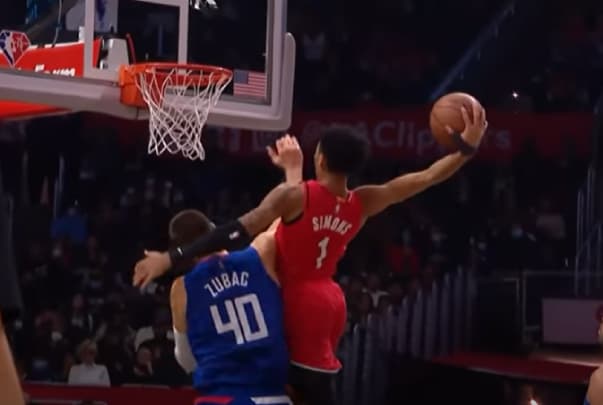Portland Trail Blazers: Dissecting Anfernee Simons’ trade value
Portland Trail Blazers guard Anfernee Simons is the subject of many trade rumors. We take a look at what his value is to other teams.

Portland Trail Blazers guard Anfernee Simons is the subject of many trade rumors. We take a look at what his value is to other teams.
Anfernee Simons seems to be the name most mentioned in potential Portland Trail Blazers trades to upgrade the roster. His value in hypothetical trade ideas fluctuates between Rip City fans and the rest of the league.
Why are other teams undervaluing Simons? Here are three misconceptions.
1. Anfernee Simons is a poor defender
If this argument sounds familiar, it’s left over from the seven years of CJ McCollum being labeled a poor defender as the Portland Trail Blazers’ shooting guard. It’s not an incorrect sentiment, as being paired with another poor defender in Damian Lillard has resulted in one of the worst defensive guard tandems over the last eight seasons.
McCollum and Simons aren’t as bad as people like to believe. As a matter of fact, they have the same issues.
Both are score-first point guards (Just like Damian Lillard) that are forced to play undersized and out of position next to Damian Lillard.
Lillard is a worse defender than either of them. He’s so good offensively that the Portland Trail Blazers have to hide him defensively. Sort of like what Houston, Brooklyn, and Philly did with James Harden.
Before McCollum was traded to New Orleans at the 2021 trade deadline, the Pelicans ranked 20th defensively. The previous season they ranked 18th.
This past season with McCollum not forced to defend shooting guards, NOP jumped up to the NBA’s 6th-ranked defense. To be fair, there’s no implying that he’s s good enough defender to catapult a team up that high (from 20th to 6th). But it does show McCollum isn’t as bad a defender as originally thought.
Simons, if given a similar change, moving away from defending shooting guards, could lead to better outcomes on the defensive side of the court. He has the athleticism and skills to be a net-positive defender, or at the least, not such a big liability.
2. Anfernee Simons is only a volume scorer
Another criticism of Simons is that he is simply a volume scorer. It’s almost the same argument as above
The same argument I’ve made regarding Simons not being maximized defensively while guarding shooting guards instead of point guards can be made about Simons not being maximized offensively when playing shooting guard.
Over the last two seasons, when Simons played point guard without CJ McCollum or Damian Lillard, he averaged 26.1 points and 5.8 assists per game in a 27-game sample. His points and assists increase is almost identical to the increases McCollum saw when playing lead guard without Dame on the court.
The big difference between CJ and Simons is that McCollum reached his prime in Portland. He fully developed and was arguably starting a decline when the Portland Trail Blazers dealt him away.
Anfernee Simons turns 24 on June 8 and is already putting up these kinds of numbers without Dame before he has even reached his full potential. In comparison, Dame was 25 years old before he had season averages of more than 21 PPG and 6.2 APG.
3. Simons’ skillset doesn’t have a high value
Whether it be sports writers or fans of other teams, the common theme, whether it’s on purpose or not, is to value Simons strictly based on his performances as a shooting guard. So when evaluating him, his lack of defense and volume shooting criticisms are almost always mentioned to lower his value.
For those who watch the Portland Trail Blazers on a regular basis, we see the real potential of Simons, his PG form that only gets unlocked in Lillards’ absence.
Simons’ actual value should be determined by what role he plays for said team. With Lillard already occupying the point, saying Simons doesn’t have a valuable skill set isn’t a fair assessment of what he can do.
What Simons should bring back
The desperation of needing wing defense will lead to an overpayment for a small forward that fills Portland’s need. That’s why the Blazers could Simons and a pair of future first round picks for an OG Anunoby.
Though that is an overpayment, that’s what the Portland Trail Blazers should be willing to pay. However, if Dame gets traded and Scoot Henderson isn’t available to be his replacement, my value of Simons skyrockets.
In that scenario, Simons for OG straight up wouldn’t cut it. Such is Simons’ value when thrust into the starting lead guard position. This is an example of value fluctuation.
In conclusion
Properly valuing Anfernee Simons should fluctuate for whoever would be trading for Simons and what role he plays. If a team like Toronto or Boston plans on starting him at the point, then he’s going to blow up offensively while minimizing his defensive liability.
On the other hand, if a team already has their point guard then Simons is going to have less value. He will once again be out of position as a shooting guard. The role that exposes his weaknesses.
This will become an issue if the Portland Trail Blazers wind up attaching Simons to the #3 pick in outgoing trades. If that pick is Scoot Henderson, whoever is planning on building a future backcourt of Simons and Scoot will be adopting those same weaknesses that Simons has.
If that pick is Brandon Miller, and said Simons plays the lead guard, then that team will maximize both Simons and Miller to their potential.
This is a weird value conundrum because Scoot has higher value trade-wise than Miller does. But Simons in a Portland Trail Blazers trad added on with Scoot, the veteran’s worth.
Next time up is what I think the Portland Trail Blazers should do to maximize all of their assets. Thanks for reading, and as always, please leave your thoughts and comments down below.
